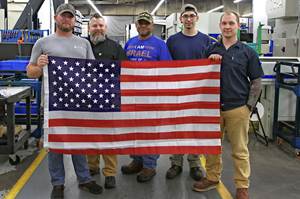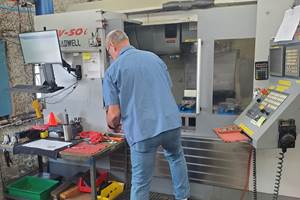What Is the Next Big Thing for Your Shop? Three Top Shops Winners Reply
All their replies pointed to automation. One also sees additive manufacturing. Watch video from the Top Shops Conference.
Share






In a Q&A session at Modern Machine Shop’s Top Shops Conference, representatives of three Top Shops Honors Program winners—Land Sea Air Manufacturing, Richards Industries and X-L Machine Co.—all were asked, “What is the next big thing for your shop?” The video clip captures their answers.
Transcript:
Peter Zelinski, Modern Machine Shop
So, the gentleman didn't have a microphone, so to paraphrase his question, or to quote it literally, “What's the next big thing?” [What is] an idea or a technology that you guys are really looking at as potentially very impactful?
Carl Livesay, Land Sea Air Manufacturing
That's a great question. For us, it's robotics. And it’s eliminating machine tenders. Okay? And I don't mean eliminating as in getting rid of them. I mean, as in escalating them up, turning them into machinists. So, machine tending is typically, on its best day in our shop, it is a semi-skilled responsibility. In most cases, it's unskilled. So, we're actually looking—in fact, I was talking to the guys over at FANUC yesterday, and I forget the gentleman's name that's doing a presentation here today at 3. We're looking to replace the non-value-added activity of loading and unloading the machine with a task robot that can be moved from machining center to machining center and set up in a couple of hours to do the load and unload. And we think that's…. Labor rates are getting up there, right? And you know, there's a move afoot at least in Maryland to make the minimum wage like $15 an hour. Now, our machinists are—I'll say our semi-skilled folks are $15 an hour, but if I'm going to pay for machine tenders that's a substantially lower cost, lower responsibility. I can rent (forget about buy for the time being)—I can rent a robot for $7.50 an hour. So yeah, I'm on that, like a big dog.
Chris Orlowski, X-L Machine Co.
For X-L Machine, the same thing. Industry 4.0, it’s the hot topic and that's exactly what we're looking at doing for some of our continuous work cells. Something that can and will run by itself because we cannot hire anybody, not even as general labor where we're at. So we're continuously working with high schools and getting students to come into our apprenticeship program, but those guys are not going to be the ones that are going to run machines, right? Or operate machines. We have to get a way of operating machines without having the problem of somebody calling in sick, without having the problem of just misloads consistently. That's our number-one internal scrap rate is misloads, and to have something with consistency and be able to read the part and then the part goes into the machine and then you have a robot of some sort that can transfer from machine to the next machine, and being able to integrate quality in there as well [via] probing and CMMs is going to be a huge feat. So that's our challenge.
Bill Metz, Richards Industries
As far as we're concerned at Richards, we are looking at robotics, but we are very high-mix, low-volume, but I do believe that there will be a time that it will be justified. Robots are obviously becoming smarter and smarter and more and more flexible. And we have the same problem as everybody else, hiring people. So that's something we're constantly looking for. I don't think we're ready yet. Machine data collection, obviously is key for what we're doing.
And then we’re also dabbling in 3D additive manufacturing. Why I say “dabbling:” We got a little tabletop unit, but it's amazing how we've used that for some pretty simple inspection fixtures—things like that. So, I think our next step will be expand on 3D additive manufacturing, probably still in the plastics area, but then you've got an opportunity with some of the low-volume stuff that we do, [including] developing patterns through 3D printing that you can then use for castings and eliminate the lead time for patterns in molds as well as the costs associated with those. So those are the things that I think are continuing to drive change.
Related Content
Finding Skilled Labor Through Partnerships and Benefits
To combat the skilled labor shortage, this Top Shops honoree turned to partnerships and unique benefits to attract talented workers.
Read MoreTop Shops: Designing a Shop to Meet Customer Needs
Working closely with customers and making careful investments has enabled this Wisconsin machine shop to tackle difficult jobs with tight deadlines as a core part of its business.
Read MoreMachine Shop MBA
Making Chips and Modern Machine Shop are teaming up for a new podcast series called Machine Shop MBA—designed to help manufacturers measure their success against the industry’s best. Through the lens of the Top Shops benchmarking program, the series explores the KPIs that set high-performing shops apart, from machine utilization and first-pass yield to employee engagement and revenue per employee.
Read MoreJob Shops Can’t Do Everything, And That’s OK
Deciding to narrow down its jobs and customers was a turning point for 2023 Top Shops Business Strategies honoree Manda Machine that has led to improvements in the front office and on the shop floor.
Read MoreRead Next
AMRs Are Moving Into Manufacturing: 4 Considerations for Implementation
AMRs can provide a flexible, easy-to-use automation platform so long as manufacturers choose a suitable task and prepare their facilities.
Read MoreMachine Shop MBA
Making Chips and Modern Machine Shop are teaming up for a new podcast series called Machine Shop MBA—designed to help manufacturers measure their success against the industry’s best. Through the lens of the Top Shops benchmarking program, the series explores the KPIs that set high-performing shops apart, from machine utilization and first-pass yield to employee engagement and revenue per employee.
Read More




















